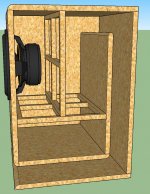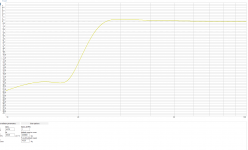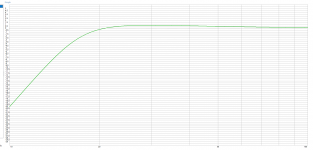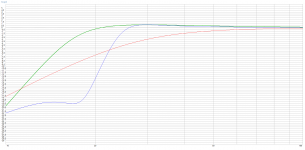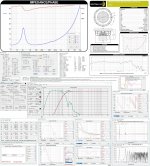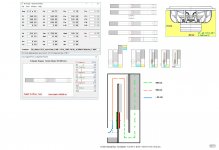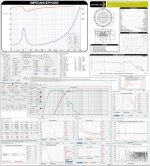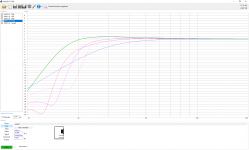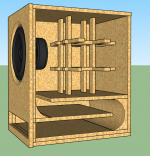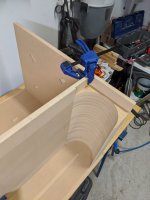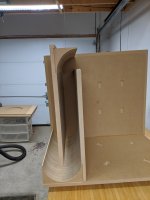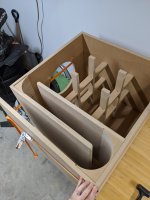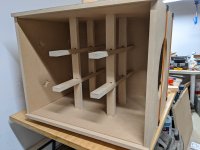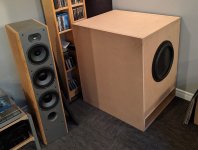To avoid many of the problems that are caused by subwoofers with ports, use passive radiators instead.
Interesting... I have never used passive radiators. Would thay give me the same output as a ported enclosure?
At from "chuffing" there are other matters to consider, such as vent compression at high SPL levels. Aiming for a peak that doesn't exceed 17 m/s is a good idea, but for my last build I measured up to 2dB of compression at Fb with a vent design that theoretically reached a peak of only 8.5 m/s.
Sounds more like rapid VC heating as vent efficiency rises, damping the system as they null each other out, the bane of prosound back in the days of near/at Av = Sd vents and low temp VCs.
GM
Sounds more like rapid VC heating as vent efficiency rises, damping the system as they null each other out, the bane of prosound back in the days of near/at Av = Sd vents and low temp VCs.
I think that the test signal was too short for any significant VC heating to happen during the testing. The sine sweep used for the test also started at a low frequency and ramped upwards in frequency, to ensure that if any heating did occur, it would start showing up at higher frequencies first.
Just because it's fun to run simulations... here is a comparison: All boxes are 10 cu ft, green is ported @ 18 Hz, Blue is passive radiator, and red is sealed.
Did you load the PR with enough mass to achieve the desired tuning frequency? It doesn't seem that way. At the product page on the PE web site there is a NOTE at the bottom:
Use the data in the table.Note: Parameters above are for the passive only with no additional mass added. Parameters with additional mass added are listed in the table below.
The PR comes with a threaded rod and several washer-like slugs (as pictured at PE product page). You add mass (up to some max limit) and the more you add the lower the tuning frequency. It's like making a port longer, except there are no (zero zilch nada) port resonances. On the downside, all that mass will generate force, leading to vibration. Using two opposed PRs is one way to practically eliminate any vibration.
There are much better PRs that this one from AE Speakers or CSS, with higher Xmax and more mass capability. If the subwoofer and PR are the same diamter, you will need two PRs because their cone excursion will be more than the driver.
The potential for vibration, and the additional cost of a good PR compared to a port tube, are some disadvantages of PR systems. But they will not have any port resonances and for the same tuning frequency can be on average smaller in volume. When you want to go low and not have a HUGE box (needed to keep port length down), PRs are a good solution.
Hi All,
FYI:
b🙂
Bjorno, FYI when you post the results of your sims as an image it is almost impossible to read anything, so it's not all that helpful. Maybe you could split it into 4 separate images or something?
Hi Charlie,
I tested to open my Picture and Clicked on it to Magnify...it did.
b🙂
I have a 28" monitor (and not one of the wide format ones either) and when I "maximize" the picture the font in most areas would need a magnifying glass to be readable. I have had this problem for pretty much everything you post in this way, so I don't get much out of it. Maybe others are in the same boat.
Attached is a screen shot as a PNG (uncompressed) file. I can't read graph labels, text, etc. Since that is all you post, no explanation or text about what is going on, there is not much to learn...
Attachments
Last edited:
I have a 28" monitor (and not one of the wide format ones either) and when I "maximize" the picture the font in most areas would need a magnifying glass to be readable. I have had this problem for pretty much everything you post in this way, so I don't get much out of it. Maybe others are in the same boat.
Attached is a screen shot as a PNG (uncompressed) file. I can't read graph labels, text, etc. Since that is all you post, no explanation or text about what is going on, there is not much to learn...
I see, but when I open the Picture first time I get the same result as you if not clicking on the lower left Corner Magnifying Icon.
b🙂
I just learned that trick this morning...click on the expando symbol at the bottom left corner then scroll around to take in the details, the many details provided.
I see, but when I open the Picture first time I get the same result as you if not clicking on the lower left Corner Magnifying Icon.
b🙂
Holy Cow! I think I have never actually used that feature. I was only looking at the cursor, which is sometimes like a magnifying glass and can be a "+" or "-" to indicate when the image can be expanded or reduced.
I must be getting old to not figure out this kind of thing before now...
Sorry!
Did you load the PR with enough mass to achieve the desired tuning frequency? It doesn't seem that way. At the product page on the PE web site there is a NOTE at the bottom:
Use the data in the table.
The PR comes with a threaded rod and several washer-like slugs (as pictured at PE product page). You add mass (up to some max limit) and the more you add the lower the tuning frequency. It's like making a port longer, except there are no (zero zilch nada) port resonances. On the downside, all that mass will generate force, leading to vibration. Using two opposed PRs is one way to practically eliminate any vibration.
There are much better PRs that this one from AE Speakers or CSS, with higher Xmax and more mass capability. If the subwoofer and PR are the same diamter, you will need two PRs because their cone excursion will be more than the driver.
The potential for vibration, and the additional cost of a good PR compared to a port tube, are some disadvantages of PR systems. But they will not have any port resonances and for the same tuning frequency can be on average smaller in volume. When you want to go low and not have a HUGE box (needed to keep port length down), PRs are a good solution.
Thanks Charlie, not sure how I missed the table...I ran some sims with the different mass added but still comes short compared to the ported enclosure. See picture attached which represents Sealed(blue) PR 0-3-6 disk(pink) and Ported(green). Now I understands that the ported enclosure is bigger but that's not a issue for me as i have more than enough space in the HT.
Would you have some PR part number that might fit well with the UM15-22? I'm a total noob when it comes to PRs so suggestions are welcomed! If i can match the response that I get from the ported enclosure that has a F3 @16.5 Hz, I just migh give it a try!
Also, here is a new version of the square port using all the bottom of the enclosure as a "snake" port, sounds like a CNC party!
Attachments
The Build
Hi everyone, here is an update. I finally got to build the box! Here are some pictures of the build. Measurements results to come later!
Cheers!
Hi everyone, here is an update. I finally got to build the box! Here are some pictures of the build. Measurements results to come later!
Cheers!
Attachments
Last edited:
Awesome build! And great work on the port! Did you use any lining on the internal walls? What was the final volume, port length and area?
- Home
- Loudspeakers
- Subwoofers
- Home theater subwoofers with UM15-22 drivers and Crown K2 amp
